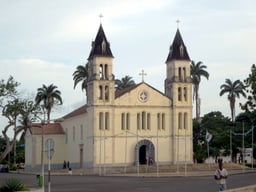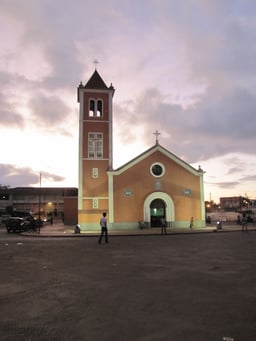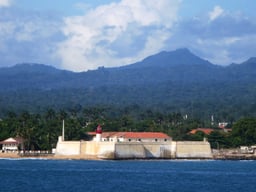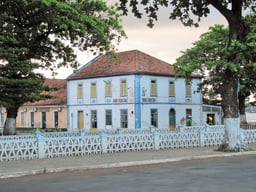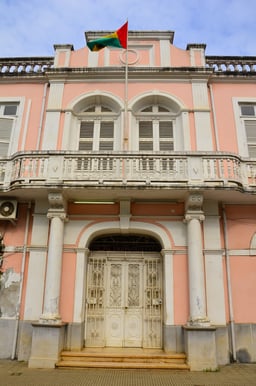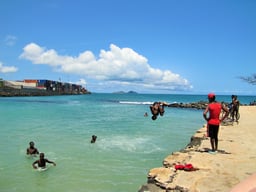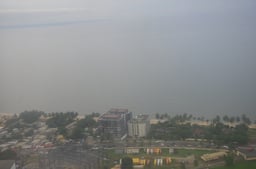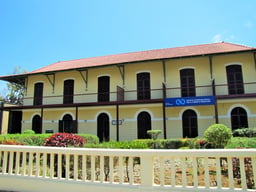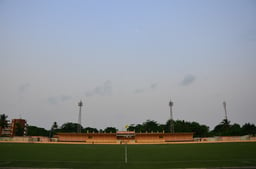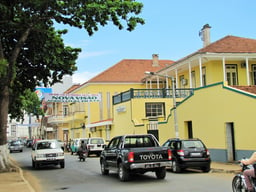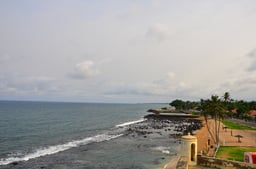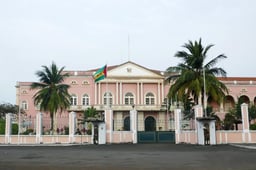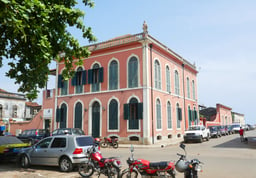São Tomé
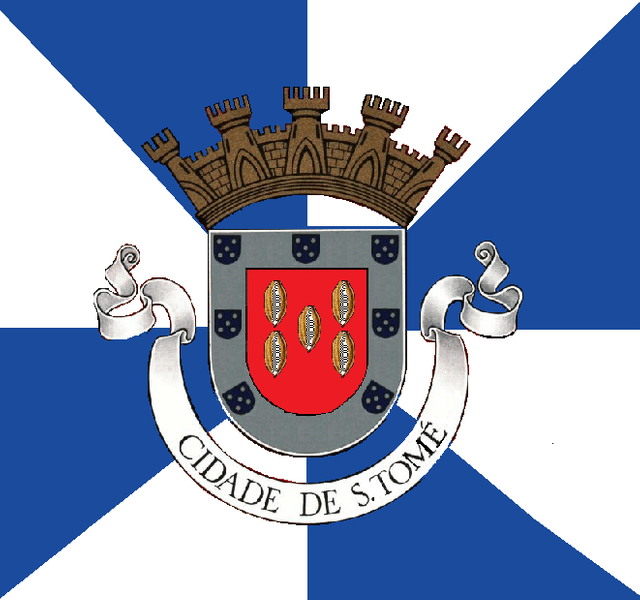
São Tomé

São Tomé | |
|---|---|
City | |
 Praça da Independência, São Tomé | |
| Coordinates:0°20′10″N 6°43′50″E [13] | |
| Country | São Tomé and Príncipe |
| Island | São Tomé |
| District | Água Grande |
| Founded | 1485 |
| Area | |
| • Total | 17 km2(7 sq mi) |
| Elevation | 137 m (449 ft) |
| Population (2015 estimate) | |
| • Total | 71,868 |
| • Density | 4,200/km2(11,000/sq mi) |
| Time zone | UTC+0 (GMT) |
| Area code(s) | +239-11x-xxxx through 14x-xxxx |
São Tomé is the capital and largest city of São Tomé and Príncipe. Its name is Portuguese for "Saint Thomas". It had an estimated population of 71,868 in 2015, accounting for over a third of the total population of the country (208,000).[1]
São Tomé | |
|---|---|
City | |
 Praça da Independência, São Tomé | |
| Coordinates:0°20′10″N 6°43′50″E [13] | |
| Country | São Tomé and Príncipe |
| Island | São Tomé |
| District | Água Grande |
| Founded | 1485 |
| Area | |
| • Total | 17 km2(7 sq mi) |
| Elevation | 137 m (449 ft) |
| Population (2015 estimate) | |
| • Total | 71,868 |
| • Density | 4,200/km2(11,000/sq mi) |
| Time zone | UTC+0 (GMT) |
| Area code(s) | +239-11x-xxxx through 14x-xxxx |
History
Álvaro Caminha founded the colony of São Tomé in 1493. The Portuguese came to São Tomé in search of land to grow sugarcane. The island was uninhabited before the arrival of the Portuguese sometime around 1470. São Tomé, situated about 40 kilometres (25 mi) north of the equator, had a climate wet enough to grow sugarcane in wild abundance. 2,000 Jewish children, eight years old and under, were taken from the Iberian peninsula for work on the sugar plantations.[2] The nearby African Kingdom of Kongo eventually became a source of slave labor as well. São Tomé is centred on a sixteenth-century cathedral, that was largely rebuilt in the 19th century. Another early building is Fort São Sebastião, built in 1566 and now the São Tomé National Museum. On July 9, 1595, a slave revolt led by Rei Amador took control of the capital; they were subjugated the following year.[3] In 1599, the Dutch took the city as well as the islands for two days; they re-occupied it in 1641 for a year. The city served as the capital of the Portuguese colony of São Tomé and Príncipe and, from São Tomé and Príncipe's independence in 1975, as capital of the sovereign nation.[4]
Geography
Important as a port, São Tomé is located on Ana Chaves Bay in the northeast of São Tomé Island, and Ilhéu das Cabras lies nearby offshore. São Tomé is located northeast of Trindade, southeast of Guadalupe and northwest of Santana. It is linked to these towns by a highway which encircles the entire island of São Tomé. It is linked to Cape Verde by a weekly ferry.
Features of the town include the Presidential Palace, the cathedral, and a cinema. The city is also home to schools,and middle schools, high schools, one polytechnic, two markets, three radio stations, the public television station TVSP, several clinics and hospitals, the country's main airport - São Tomé International Airport (with direct regular scheduled flights to Angola, Gabon, Ghana and Portugal as well as occasional domestic flights to Príncipe), and many squares (praças). São Tomé also serves as the centre of the island's road and bus networks. The town is well known for the tchiloli playing.
Population history
| Historical population | ||
|---|---|---|
| Year | Pop. | ±% |
| 1990 (June 23, Census) | 42,331 | — |
| 2000 (June 16, Census) | 49,957 | +18.0% |
| 2003 (Estimate) | 53,300 | +6.7% |
| 2018 (July 1, Estimate) | 71,868 | +34.8% |
Transport
São Tomé is served by São Tomé International Airport (IATA: TMS, ICAO: FPST) with regular flights to Europe and other African Countries.
Climate
São Tomé features a tropical wet and dry climate (As) with a relatively lengthy wet season and a short dry season. The wet season runs from October through May while the dry season covers the remaining four months. São Tomé sees on average just under 1,000 mm (39 in) of precipitation per year. Temperatures in the city are relatively constant, with average high temperatures usually around 30 °C (86 °F) and average low temperatures around 22 °C (72 °F).
| Climate data for São Tomé (São Tomé International Airport) | |||||||||||||
|---|---|---|---|---|---|---|---|---|---|---|---|---|---|
| Month | Jan | Feb | Mar | Apr | May | Jun | Jul | Aug | Sep | Oct | Nov | Dec | Year |
| Record high °C (°F) | 32.0 (89.6) | 33.6 (92.5) | 33.5 (92.3) | 33.4 (92.1) | 33.9 (93.0) | 31.0 (87.8) | 30.7 (87.3) | 31.0 (87.8) | 31.7 (89.1) | 31.5 (88.7) | 31.6 (88.9) | 32.0 (89.6) | 33.9 (93.0) |
| Average high °C (°F) | 29.4 (84.9) | 29.9 (85.8) | 30.2 (86.4) | 30.1 (86.2) | 29.3 (84.7) | 28.0 (82.4) | 27.3 (81.1) | 27.7 (81.9) | 28.6 (83.5) | 28.7 (83.7) | 29.0 (84.2) | 29.1 (84.4) | 28.9 (84.0) |
| Daily mean °C (°F) | 25.9 (78.6) | 26.2 (79.2) | 26.4 (79.5) | 26.4 (79.5) | 26.0 (78.8) | 24.7 (76.5) | 23.8 (74.8) | 24.1 (75.4) | 25.0 (77.0) | 25.2 (77.4) | 25.5 (77.9) | 25.6 (78.1) | 25.4 (77.7) |
| Average low °C (°F) | 22.4 (72.3) | 22.5 (72.5) | 22.6 (72.7) | 22.6 (72.7) | 22.6 (72.7) | 21.4 (70.5) | 20.4 (68.7) | 20.5 (68.9) | 21.3 (70.3) | 21.8 (71.2) | 22.0 (71.6) | 22.1 (71.8) | 21.8 (71.2) |
| Record low °C (°F) | 19.1 (66.4) | 19.6 (67.3) | 19.2 (66.6) | 19.4 (66.9) | 18.5 (65.3) | 14.0 (57.2) | 14.0 (57.2) | 13.4 (56.1) | 16.0 (60.8) | 18.3 (64.9) | 18.8 (65.8) | 19.6 (67.3) | 13.4 (56.1) |
| Average precipitation mm (inches) | 81 (3.2) | 84 (3.3) | 131 (5.2) | 122 (4.8) | 113 (4.4) | 19 (0.7) | 0 (0) | 1 (0.0) | 17 (0.7) | 110 (4.3) | 99 (3.9) | 108 (4.3) | 884 (34.8) |
| Average precipitation days(≥ 0.1 mm) | 8 | 8 | 12 | 11 | 10 | 3 | 2 | 3 | 6 | 12 | 11 | 8 | 94 |
| Average relative humidity (%) | 85 | 84 | 83 | 83 | 84 | 79 | 77 | 78 | 79 | 82 | 85 | 85 | 82 |
| Mean monthly sunshine hours | 142.6 | 135.6 | 139.5 | 126.0 | 145.7 | 165.0 | 161.2 | 148.8 | 120.0 | 114.7 | 135.0 | 142.6 | 1,676.7 |
| Mean daily sunshine hours | 4.6 | 4.8 | 4.5 | 4.2 | 4.7 | 5.5 | 5.2 | 4.8 | 4.0 | 3.7 | 4.5 | 4.6 | 4.6 |
| Source: Deutscher Wetterdienst[5] | |||||||||||||
Education
University of São Tomé and Príncipe, formed in 2016
National Lyceum
Patrice Lumumba Preparatory School
National Library of São Tomé and Príncipe
The following Portuguese international schools are in the city:[6]
Escola Portuguesa de S. Tomé
Instituto Diocesano de Formação João Paulo II
Escola Bambino
Escola Internacional de S. Tomé e Príncipe
Health
The main hospital of the country is Hospital Ayres de Menezes.
Sports
Sports clubs based in the city include Sporting Praia Cruz and Vitória FC based in the neighborhood of Riboque. All clubs play at Estádio Nacional 12 de Julho.
Places of worship
Among the places of worship, they are predominantly Christian churches and temples : Roman Catholic Diocese of São Tomé and Príncipe (Catholic Church), Universal Church of the Kingdom of God, Assemblies of God. [7]




